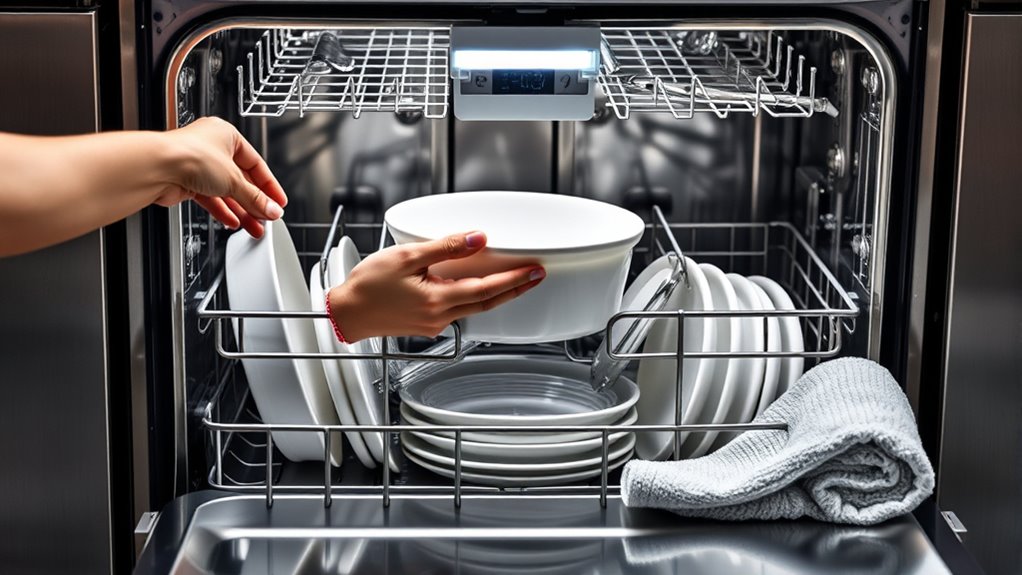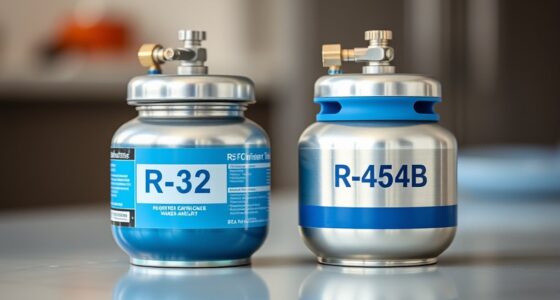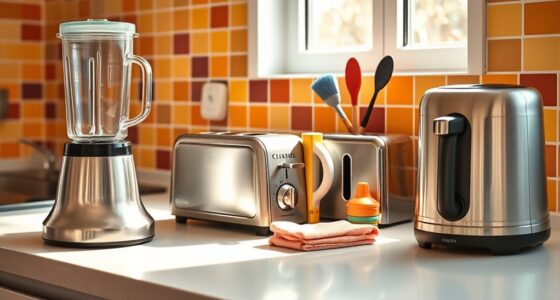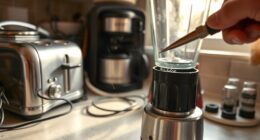To guarantee your countertop dishwasher dries dishes effectively, load them with space between items to promote airflow and prevent moisture entrapment. Avoid overcrowding and angle items with dirty surfaces facing water jets for maximum cleaning and drying. Proper placement helps water and air circulate freely, reducing drying time and residue. By following these loading tips, you’ll get faster, sparkling, dry dishes every cycle. Keep exploring to discover more ways to optimize your dishwasher’s performance.
Key Takeaways
- Avoid overcrowding to ensure proper airflow and moisture evaporation for faster, more effective drying.
- Load dishes with their dirty surfaces facing water jets, and leave space for air circulation.
- Properly organize dishes and utensils to prevent moisture entrapment and promote even drying.
- Use appropriate drying cycles and avoid overloading to enhance energy-efficient drying performance.
- Regularly check and maintain dishwasher components to prevent moisture issues and improve drying results.
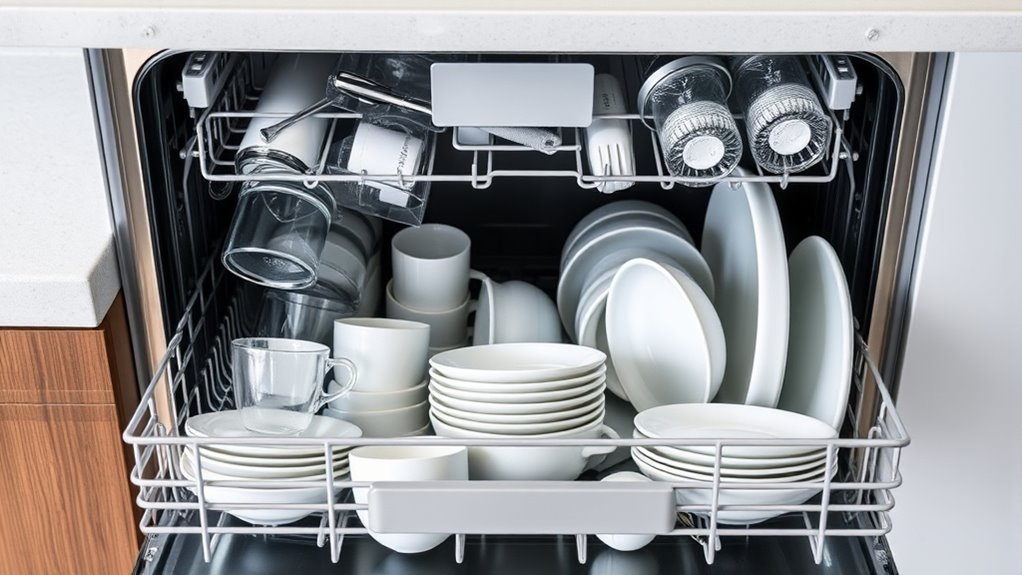
Loading your countertop dishwasher correctly guarantees your dishes come out spotless and prevents damage to the appliance. Proper loading not only ensures thorough cleaning but also maximizes energy efficiency, saving you time and money on utility bills. When you carefully place dishes, you allow water and heat to circulate freely, making each cleaning cycle more effective. Start by positioning larger items like plates and pots along the sides or back, ensuring they don’t block the spray arms. Overloading the dishwasher can hinder water flow, leading to inadequate cleaning and longer or more frequent cycles. Keep in mind that optimized loading allows your dishwasher to operate at peak energy efficiency, reducing overall electricity consumption. Additionally, maintaining a well-organized load helps prolong the lifespan of your appliance by minimizing strain on its components.
Proper loading ensures spotless dishes, prevents damage, and boosts energy efficiency for optimal dishwasher performance.
Next, take advantage of the various cleaning cycles your countertop dishwasher offers. Different cycles are designed to handle specific levels of soil and types of dishes. For lightly soiled glasses and cups, a quick or eco-friendly cycle often suffices, conserving both water and energy. For heavily soiled pots and pans, select a more intensive cycle that uses higher water temperature and longer wash times. Properly loading your dishwasher ensures these cycles work efficiently; if dishes are packed too tightly, water may not reach all surfaces, defeating the purpose of choosing a specific cycle. Conversely, leaving enough space between items allows water and detergent to penetrate thoroughly, improving cleaning results. There is also a benefit in understanding the importance of dishwasher maintenance to keep your appliance functioning optimally over time.
When loading, pay attention to the placement of smaller items like utensils and plasticware. Use the designated compartments or baskets to prevent them from falling into the spray path or blocking the spray arms. This helps maintain consistent cleaning performance across all items and minimizes the need for re-washing. Also, make sure dishes are angled correctly, with dirty surfaces facing toward the water jets. This orientation maximizes the effectiveness of each cleaning cycle, especially when you’re working with different cycle options tailored for specific cleaning needs. Proper loading not only enhances cleaning but also contributes to more efficient drying, as good airflow prevents moisture from being trapped.
Finally, remember that proper loading impacts not only cleaning quality but also the drying process. Avoid overcrowding, which traps moisture and prolongs drying time. Many countertop dishwashers now feature energy-efficient drying options that work best when dishes are loaded correctly, with enough space for airflow. By paying close attention to how you load your dishwasher, you ensure that each cleaning cycle, whether quick or intensive, delivers sparkling results while using less energy. This mindful approach prolongs the lifespan of your appliance and keeps your dishes spotless after every wash.
Frequently Asked Questions
How Can I Prevent Water Spots on Dishes After Drying?
To prevent water spots on your dishes after drying, make sure you use a rinse aid, which helps water sheet off and reduces spots. Also, avoid overloading your dishwasher, so water can circulate properly. Using the correct water temperature and selecting a drying cycle can help, too. Regularly clean your dishwasher’s filter and spray arms to guarantee ideal performance. These steps will keep your dishes sparkling and spot-free.
Does Load Size Affect Drying Efficiency in Countertop Dishwashers?
Like a well-oiled machine, your countertop dishwasher works best when the load size is just right. A larger load can hinder water circulation, leaving dishes damp or streaky, while a smaller one allows hot air and water to circulate freely, boosting drying efficiency. Proper load arrangement guarantees even drying, as water and heat reach all items uniformly. Keep the load balanced, and your dishes will dry faster and more effectively.
Are There Specific Detergents That Improve Drying Performance?
Yes, using specialized detergents with added drying agents can enhance drying performance in your countertop dishwasher. These detergents help break down residues that trap moisture and promote faster evaporation. Look for products labeled as containing drying agents or designed for quick drying. Using the right detergent ensures your dishes come out drier, reducing the need for towel drying and making cleanup more efficient.
Can Improper Loading Cause Dishes to Remain Wet After Drying?
Did you know improper loading can leave up to 30% of dishes wet? Yes, if you don’t pay attention to dish placement and loading patterns, your dishwasher won’t dry effectively. You might block vents or overcrowd the rack, preventing air from circulating properly. To improve drying, guarantee dishes are spaced correctly, and avoid stacking items too tightly. Proper loading helps your dishwasher do its job and leaves your dishes sparkling dry.
Is It Better to Open the Dishwasher Immediately After the Cycle?
Yes, it’s better to open the dishwasher immediately after the cycle. Doing so allows the vents to release steam, preventing moisture buildup. Opening the door slightly lets hot air escape, which helps dishes dry faster and reduces water spots. Use the drying racks for better airflow and guarantee the vents aren’t blocked. This quick step improves drying efficiency and keeps your dishes spotless and dry.
Conclusion
Now that you’ve mastered countertop dishwasher loading, your dishes will come out spotless and dry, saving you time and effort. It’s a simple step that transforms chaos into clarity, much like turning cluttered countertops into sleek surfaces. With the right loading technique, you get the best of both worlds: sparkling clean dishes and a tidy kitchen. So, embrace the process—because in this small act, efficiency and order meet, making your daily routine smoother.
